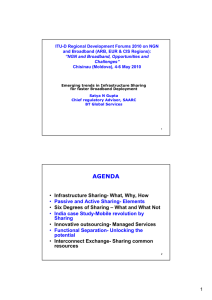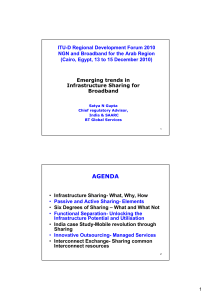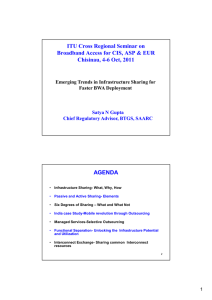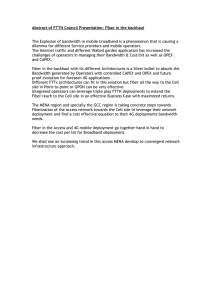ITU Regional Forum for Arab Region: IMT Systems, Technology, Evolution and Implementation
advertisement
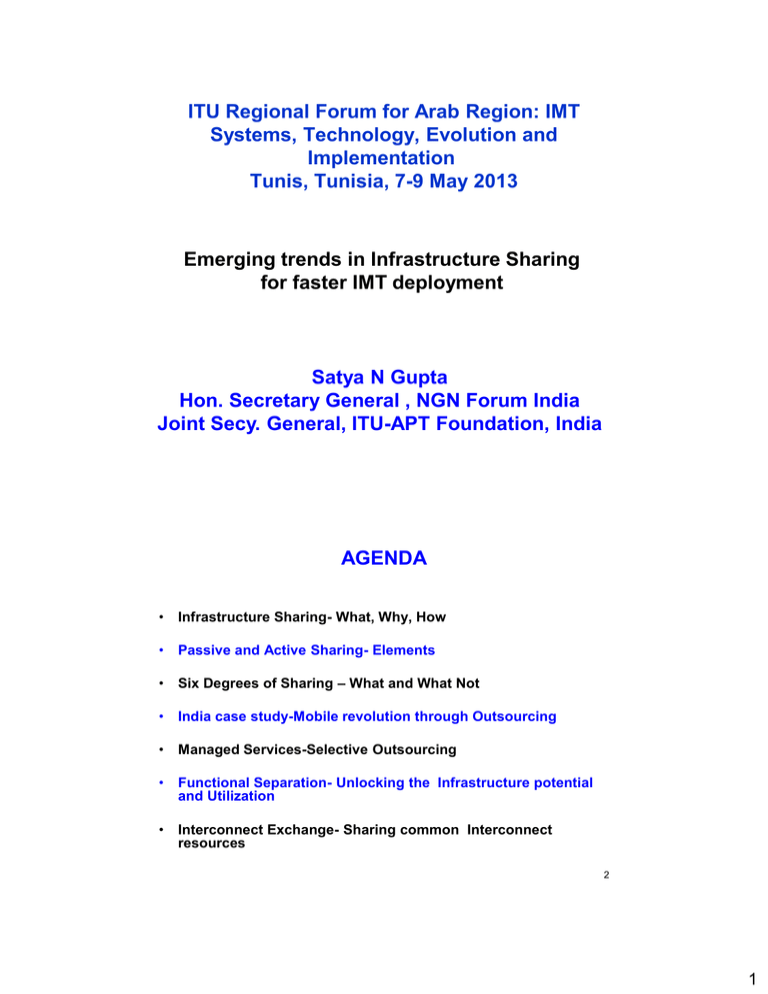
ITU Regional Forum for Arab Region: IMT
Systems, Technology, Evolution and
Implementation
Tunis, Tunisia, 7-9 May 2013
Emerging trends in Infrastructure Sharing
for faster IMT deployment
Satya N Gupta
Hon. Secretary General , NGN Forum India
Joint Secy. General, ITU-APT Foundation, India
AGENDA
•
Infrastructure Sharing- What, Why, How
•
Passive and Active Sharing- Elements
•
Six Degrees of Sharing – What and What Not
•
India case study-Mobile revolution through Outsourcing
•
Managed Services-Selective Outsourcing
•
Functional Separation- Unlocking the Infrastructure potential
and Utilization
•
Interconnect Exchange- Sharing common Interconnect
resources
2
1
What is Telecom Infrastructure?
•
•
•
Passive: Non- Electronic (Civil and Electrical) Elements
Towers, Masts, Posts, Power System, Land , Building, Duct,
Dark Fiber, Trenches, Air- conditioning, Co-location space etc.
Active: Electronic Elements
– Switches/Routers : TDM and IP based
– Transport network
• OFC- Long Distance Carrier
• Wireless: M/W, Satellite, Antenae
– Access network
• Copper: Local loop( Full, Partial, Bit-stream/ALA)
• Fiber: Back Haul and FTTX
• Wireless: BTS,BSC,MSC
– Applications, Software, NMS
– IN Platform, BSS, OSS, International Gateways, LIM
– Radio Spectrum
3
What to share?
•
•
•
•
Any Element which has spare Capacity
Any Element which can be Pooled
Any Element which is a Bottleneck
Passive & Active elements
– Passive Infrastructure
– Access Network
– Carrier/Transport/Backhaul
– Billing System, NMS,OSS, IN
– Applications/Software
– Common interconnect points, Gateways, Radio Spectrum,
LIMS(Lawful Interception and Monitoring System)
4
2
Why Share?
Cost cutting- Single biggest reason to share.
Developing countries seek to leverage mobile infrastructure
boom into Broadband/ IMT deployment.
Developing countries seek to build IP-based backbone and
backhaul networks ( NGN), which has enormous extra capacity
due to Packetisation.
Developed countries seek to leverage fixed line investments
and upgrade to Fibre to Home (FTTH), Building,Curb, Tower.
Both share the same goal- To accelerate network deployment
and growth by cutting costs and enhancing efficiency through
network sharing.
5
Sharing-Time is Right, Now
For many developing countries, end of exclusivity periods
A second wave of regulatory reforms could be unleashed
(Regulation V2.0)
Sharing strategies could be central to the new wave of
regulatory reform
Phenomenal help in the Downturn times to become Recessionproof.
Enabling technologies available (NGN,SDR,CR)
6
3
6 Degrees of Sharing- What it Is?
Using infrastructure sharing together with Universal Access
strategies within a competitive framework
Reducing costs through efficient usage
Allowing new players to provide services faster
Relying on time-tested Competition and Regulatory principles
Allowing markets to function freely
Enabling Consumers to get services faster and affordable
7
6 Degrees of Sharing- What it is not?
An attempt to put infrastructure back in the hands of monopoly
providers or to stifle competition (Sharing not possible if there
is only one player!)
A strategy to lessen competition or to deploy less equipment
About sharing for Free ( Cost plus charging)
Limiting consumer choices
A limit on facilities-based competition
Limiting Innovations
8
4
How to facilitate Sharing?
Share some infrastructure but still compete on end-user
Services ( Co-opetition)
Requires political will and clear regulatory framework
Many of the regulatory tools already exist in Interconnection
regulations and Competition frameworks
Can apply principles like Duct, Tower/Site sharing, Collocation,
LLU, Bit-stream/Active Loop Access, Connection services to
Mobile Infra, Fibre
Equal-Ease of Access to International Gateway facilities and
permitting Sharing of LIM
And finally Functional Separation ( The Nirvana)
9
Current economic scenario creates new
Challenges…and better case for infrastructure sharing
In the wake of the impending global recession,
the liquidity crunch has hit the companies
hard on their expansion plans, making
conditions ideal for infrastructure sharing and Managed
Services
Higher OPEX has put additional
pressure to tame the already escalating
OPEX, leaving no option except for
infrastructure sharing
Higher OPEX in
Rural Areas
Liquidity
Crunch
Government
Regulation
On Infrastructure
Sharing
Falling ARPU’s has put pressure
on TSP’s to reduce their CAPEX and opt
for infrastructure sharing
With the operators forced to reduce their
OPEX & CAPEX has put further pressure
on the rentals and would drive them
towards infrastructure sharing
Falling
ARPU’s
Rental
Pressure
With the existing regulations, under the
USO fund all the Telco’s need to share
their passive infrastructure in rural areas
10
5
Growth Drivers
Industry Forecast
600
Reduced time to market
500
Plug and play offerings – connected network with
backhaul
Large geographical coverage requirements
Heavy usage of voice services
105
142
233
410
310
564
525
473
0
Dec-06 A
Pressure on strategic site’s availability
Infrastructure sharing likely to gain momentum
with increasing competition and new entrants in
market
Government support - Government’s aim of
narrowing the “digital divide” between rural and
urban areas
Expected CAPEX savings between US$7 Bn to US$12 Bn
and additional OPEX savings of US$1 Bn, over four years
for telecom operators on account of Infrastructure Sharing
200
100
0
Allow the service provider to focus on their core
competencies
400
300
228
175
300
200
346
335
321
285
400
100
Dec-07 A
Dec-08
Dec-09
Dec-10
Subs in Million
Dec-11
Dec-12
Towers in ('000)
By 2012, approx no of towers-350,000 with tenancy ratio
of 1.8-2.0 operators per tower
Demand for infrastructure sharing will rise
due to:
Worsening
credit conditions and recent
surge in cost of capital
Demand on account of new technologies
such as 3G, Wi Max and LTE, FTTH
Operators need to prioritize capital allocation
A huge Industry in making- Minutes factories
11
Source: Broker research estimates; Ernst & Young analysis
Emerging trends in Sharing
Key Drivers
• 3G Rollout
• Wi Max/LTE
• IBS
• BTS hotels
• Backhaul
• RAN Sharing
New / Alternate / Green
Technologies
Emerging
trends
Innovative ways & means
to penetrate Rural Segment
Joint RF Planning
with Focus on Tenancy
Key Drivers
Managed Services
• Reduce Capex/ Opex
• Reduce Energy expenses
Network coverage is not a sustainable differentiator for operators
Shared infrastructure companies emerging as key strategic partners to service providers
Pressure on bottomline
Wider Coverage
Faster Rollout/ Market Penetration
Concentrate on Services
Aggressive
Active Sharing
•
•
•
•
Subs in Mn
Compelling economic value proposition
Tower ('000)
Factors driving Infrastructure Sharing
12
6
Evolution of Infrastructure sharing in India
Within a span of last 5 yrs the passive infrastructure sharing observed significant progress
Quippo Telecom, a Tower company pioneered the passive infrastructure model. Signs
up with main mobile operators Bharati, Vodafone, Idea and Spice as its customers.
July 2005
July 2007
Reliance Communication another operators hived off its tower unit and sold a 5%
stake to investors in US, Europe and Asia valuing the business at about USD 6.75 bn
December 2007
Quippo Telecom acquired 988 towers from Spice in both its operating circles of Punjab
and Karnataka
December 2007
Airtel, Vodafone & Idea cellular merged their tower assets in 16 telecom circles to form
Indus.
January 2008
A group of overseas investors acquired a 9% stake for USD 1 bn in Bharti Infratel
Limited ( Airtel tower unit)
February 2008
US based private equity company Kohlberg Kravis Roberts (KKR) invested USD 250
mn for a 2% stake in BIL
January 2009
Quippo Telecom acquired 49% stake along with management control in Tata
Teleservices tower arm - WTTIL
March 2009
American Tower Corporation(ATC) acquired Mumbai based Xcel Telecom established
in 2006 with USD 500 mn funding commitment from Q investments
June 2010
GTL Attempts for Reliance Comm Tower Infrastructure in a M&A deal worth 11Bn
US$ & also Aircel Towers.
13
Service Providers’ imperatives
Investment
Operating Margins
Go-To-Market
• Cater to low ROIC but high
rural population
• Spectrum scarcity vs.
coverage; 3G rollout will
require more towers
• Huge capacity in high MoU
areas
• Increased share of passive
in total capital expenditure
• Maintain operating margins
despite falling tariffs
• Keep rentals low despite
high demand
• Service rural population with
high cost per subscriber
• Speed of deployment and
time-to-market
• Enhance market share by
access to larger base of
towers and investment in
network and product
innovations
Capex savings :
US$7-12 b in 4 years
Opex savings:
US1b per annum
Focus on core areas to
enhance market share
Source : E & Y analysis
14
7
Aggressive Active Sharing- A new start
Next generation networks
likely to force greater sharing
(IMT)
New Usage by Subscribers - email,
text messaging, web access, &
media applications such as picture
sharing, video viewing
3G antennas need to be installed on
each tower and data equipment
needs to be added in the common
shelter beneath the tower
Greater cell-site density is required
for data-centric networks.
• Intra-circle roaming
• In Building Solution (IBS)
• BTS Hotels
• Backhaul Sharing
▪ Opex savings on both Infrastructure and
active equipment O&M
– Opex savings per site (~30-35%)
Operators
▪
Infra
Provider
▪
Target
customers
▪
▪
Capex savings (25% ~40% per site)
through leaner remote sites compared to
full fledged tower sites
Opportunity to attract incumbents to derisk the tower business
Anchor customers on new sites
Incumbents on existing and new sites
15
Support Required from Government / Regulators
Telecom Industry
•
•
•
Concentrate on market
More coverage
Faster rollout
Partner of choice in
creating prosperity
Provider
Society
•
•
Environment friendly &
Better aesthetic
Consumers
•
•
•
Wider Choice
Better Tariffs
Less call drops
Support for effective and faster rural rollout
Effective and efficient utilisation of USO funds
Single Window Clearance for various permission/ approvals
Support in generation of single invoice for electricity and subsidy for
Green energy
• Facilitate access to passive and active infrastructure
Support Required
Infrastructure
Government/ Regulatory
Authorities
•
•
•
•
16
8
Managed Services- Selective Outsourcing
A Managed Service is provided by a service provider that takes on management responsibility
for a function that has traditionally been carried out internally by a telecom operator
Managed Services functions typically
include:
• Improves bottom line
Financial
Pressures
• Design and Engg. – N/W planning,
optimization and development.
• Build – technology integration and
implementation of networks, services
and business support systems.
• Operate – day-to-day operations
such as operation and maintenance of
networks, services and business
support systems, field services,
customer
problem
management
including helpdesk, and service and
resource fulfillment
• Consolidations
Operators
• new services
Business is
• Increased
changing
competition
• price pressures
Managed
Services
Operational
Efficiencies
• Network
performance
• economies of
scale
• processes,
tools, method
Competence
Need
• Tower Operation center (TOC)
• Technology shifts
• Increased complexity
Massive deployment of high-speed wireless networks throughout has opened
up a new market for telecom outsourcing and managed services
17
Functional Separation – A Win- Win Sharing
concept powered by Managed Services
18
9
Functional Separation- What it is & What not?
1.
It is carving out a separate logical entity ( Virtual SPV) out of the
sharable under-utilized Infrastructure to unlock the full potential
without any Structural change. ( eg. ARC in banking). It can offer
Infrastructure-as-an-Interconnect-Service (I-a-a-s) on IRU (Indeafisible
Right of Use) basis.
2. It is not any form of Divestment and involves no Ownership change .
3. It does not force any Retrenchment/VRS, but converts the staff
Liability into Asset through sense of belongingness and
Accountability.
4. It converts NPA(Non-Performing Assets) into Revenue Generating
Asset (RGA) by unleashing the capacity through Modernization,
upgradation through Managed Services & Efficient Utilization.
5. It leverages the Professional Management through empowerment &
accountability along with staff participation ( Best of both the Worlds)
6. It does not force a Free/ below cost leasing but enables cost++ returns
7. It converts the Competitors into the Wholesale dealers (Co-Opetition)
8. It is a Win-Win and maximizes the National ( Societal) Welfare.
9. It is an implementable Idea whose time has come for India ( Nirvana)
10. It is not a Rocket Science- It is all about timely Execution through
Managed Services, Silly.
19
UK- Functional Separation ( BT- Openreach)
PSTN Service
PSTN & ADSL Service
Customer premises
Core Node.
CP
Core
Node
BTW
Core
Node
Local Telephone Exchange
Main
Distribution
Frame
LLUO
Space
Primary
Connection Point
(Cabinet)
Secondar
Connection
y
Point
Distribution
Point (DP)
Line
Card
Backhaul products
Copper Cables
Backplate of
NTE
openreach
openreach is also responsible for all duct, access fibre and copper & fibre backhaul
Demarcation Points
20
10
Upstream / Downstream Flows
Openreach
Access
Chinese walls
BT Whole
Sale
SMP
Services
UK Networks
Non SMP
Services
CSP(Altnet)
Retail markets
Individual
Customer
21
Sharing of Interconnect resources
•
Separate Network for Basic/Mobile (Voice) and for Data
•
Huge growth in Mobiles
•
Increasing numbers of Application developers, Operators and
Traffic
•
Every Basic/Mobile operator to have interconnection with each
other and with many NLD and ILD operators
22
11
Present Scenario (contd..)
BS1
UA1
UA2
ILDO1
NLDO1
ILDO2
NLDO2
MO3
MO4
MO5
23
Results
•
Sub-optimal utilization of resources
•
Inefficient handling of calls
•
High operational cost for managing inter operator connections
•
Inter carrier billing problems
•
Complexity in settlement in Interconnect usage charges
•
Increase in CAPEX and OPEX
24
12
Shortcomings
•
High interconnection cost
•
Connection at different levels and at many places Complex
routing at every point
•
Huge requirement of ports and their cost
•
Physical provisions at different places causes delay and need
more capacity
25
Solution- IP based IX
•
Open and Distributed Architecture
•
Best breed of products
•
Better Performance
•
Required Quality of Service
•
Efficiency in Inter- working
Thus NGN based interconnect Exchange (IP-IX) can be best
solution for interconnection
26
13
Interconnect Exchange-The Concept
BS1
US2
US3
ILDO1
NLDO1
INTERCONNECT
EXCHANGE
ILDO2
NLDO2
MO1
MO2
MO3
27
Domestic
NGN switch
International
LIS
SBC
IN
NGN NW
SBC
IE
MG
MG
TDM switch
TDM NW
Billing
ASP
28
14
Advantages
•
Network simplicity leads to reduction in interconnection cost
and port charges
– Simple network interconnection using GE or OFC as per
ITU-T G.653
– Reduction in number of links
– Simplifies digit analysis for all inter operator and long
distance calls from the switches connected to it
•
Help in quadruple (Voice, Video, Mobile TV and data) play
•
Less time consumption in provision/augmentation of PoIs
•
Help in convergence of services, application and provisioning
29
Advantages ( Contd..)
•
Simplification in carrier selection function and Number
Portability
•
Integration of different service providers at one point
•
FMC and Femto cell concept in multi operator environment in
case of intra roaming, thus saving in spectrum
•
Low latency
•
Reduction in Capex and Opex
30
15
Advantages (contd..)
•
Integrated and Inter carrier billing
– Less connection: less disputes
– Clearing house function
– Inter operator charging, based on GOS, Content and
network elements used in interconnection
•
Intelligent network services
– Easy provision in a multi operator and multi-service
scenario
– Content can be integrated at ICE and can be pooled to all
the operators connected to it
31
Who will do it?
•
Regulator and Licensor: Terms to be redefined with light touch
approach
•
All stake holders to come to-gather
•
By incumbent operator or by other or separate independent
operator
•
Management : To be decided by all stake holders
32
16
Future- back to core competency towards
minutes factory
•
Separate access providers: DSL, Wi-Fi, WiMAX, FTTX, GSM,
CDMA etc
•
Separate network providers
•
Separate long/short distance connectivity providers
•
Separate Infra: Tower, Power, BTS providers
•
Separate Operation/ Billing system providers
•
MVNO/ Virtual Operator concept
•
3rd party VAS,OTT providers
Specialized entities will handle different segments, efficiently and in
a cost effective expert manner
33
Thank You
Satya N Gupta
sngupta57@yahoo.com
34
17
